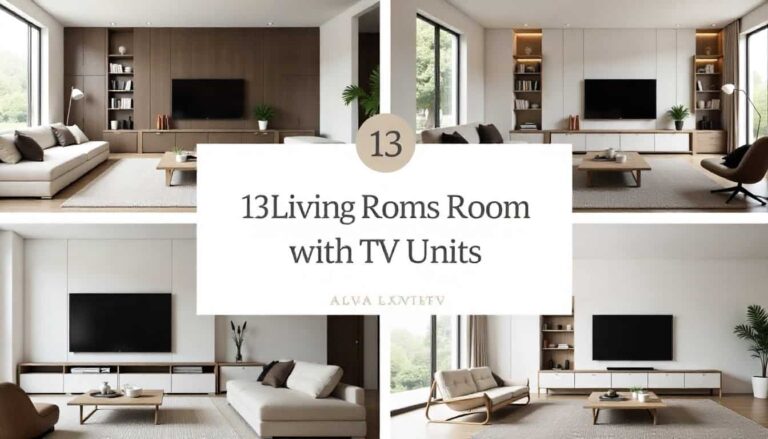21 Living Room Divider Ideas for Small Spaces
Small living spaces can be both charming and challenging. While open layouts make rooms feel airy, lack of separation can make the space feel cluttered or unorganized. That’s where living room dividers for small spaces come in. These clever solutions create distinct zones without sacrificing light or flow, making your home both functional and stylish.
From floating shelves to folding screens, each divider idea maximizes limited space while adding personality. Choosing the right divider can transform a small apartment, studio, or compact home into a cozy, practical, and visually appealing environment.
In this guide, we’ll explore 21 innovative small space divider ideas. Each concept includes styling tips and a unique image-generation prompt, helping you visualize how it can enhance your home.
1. Floating Shelf Divider for Compact Apartments
Floating shelves are perfect for small living rooms. They divide the space without taking up floor area, allowing light and air to flow freely. You can decorate them with plants, books, or small decorative items to make the divider visually appealing.
Why it works: Floating shelves maintain openness, unlike bulky partitions. They are ideal for apartments and studios where maximizing space is crucial.
Styling Tips:
- Mix books, candles, and small planters for visual interest.
- Use light-colored shelves to prevent the space from feeling heavy.
- Keep the layout balanced with minimal items on each shelf.
Image Prompt: A small modern living room with a floating shelf divider, decorated with plants and books, creating zones without crowding the space.
2. Glass Panel Divider to Maintain Light
A glass divider is a brilliant way to separate areas while maintaining brightness. Clear or frosted panels can divide a living area from a dining corner without making the room feel cramped.
Why it works: Glass keeps the space visually open, reflecting light and creating a sense of depth. It’s ideal for small apartments that need separation but also want an airy atmosphere.
Styling Tips:
- Pair with minimal furniture to maximize light reflection.
- Use frosted patterns for privacy in certain zones.
- Complement with warm lighting for a cozy feel in the evening.
Image Prompt: A tiny living room using a clear glass divider to separate the sofa area from the dining corner, keeping the room bright and airy.
3. Folding Screen Divider for Small Rooms
Folding screens offer flexible and temporary separation. They can be moved or folded away when not needed, making them ideal for small spaces.
Why it works: Screens provide privacy and style without permanent construction. They are lightweight, easy to change, and available in countless designs—from modern to vintage.
Styling Tips:
- Choose screens with light materials to avoid visual heaviness.
- Decorate with subtle patterns or pastel colors for a calming effect.
- Position near a sofa or bed for a cozy nook.
Image Prompt: A compact living room with a stylish folding screen divider, adding privacy while being flexible and easy to move.
4. Open Cube Shelf Divider
Cube shelves are multifunctional, serving as both storage and partition. They help define areas while keeping the room organized.
Why it works: Open cubes let light pass through, preventing the room from feeling closed. Small apartments benefit from their vertical storage capacity.
Styling Tips:
- Alternate between open shelves and baskets for hidden storage.
- Decorate cubes with small plants or books to add charm.
- Match the shelf finish with your furniture for harmony.
Image Prompt: A small apartment with a cube-style open shelf divider behind the sofa, used for storage and décor.
5. Curtain Divider for Cozy Corners
Fabric curtains are a soft, inexpensive way to divide small spaces. They can be drawn open or closed, providing privacy and flexibility.
Why it works: Curtains add warmth and texture, creating intimate zones without permanent structures. They are ideal for studio apartments.
Styling Tips:
- Use light fabrics like linen for an airy feel.
- Pair with tiebacks to keep the space open during the day.
- Choose colors that complement your décor palette.
Image Prompt: A minimalist living room with a light fabric curtain divider, softening the space and creating a cozy nook.
6. Low Profile Sofa Divider
A low-back sofa can act as a natural partition, dividing a living area from a dining space without blocking sightlines.
Why it works: Low sofas maintain the open feel while creating a subtle separation. They are practical in small apartments with limited floor space.
Styling Tips:
- Use a rug to define the sofa zone.
- Add pillows to create a visual boundary.
- Match sofa color with the overall décor to blend seamlessly.
Image Prompt: A small living room using a low-back sofa as a natural divider, separating seating from a dining area without blocking light.
7. Half Wall Divider with Storage
Half walls with built-in storage offer dual benefits: separation and functionality. Cabinets or drawers can hold essentials while creating a visual barrier.
Why it works: Half walls are space-efficient and can double as display or storage areas. They give the room structure without feeling boxed in.
Styling Tips:
- Keep cabinets organized to avoid clutter.
- Use décor on top, like vases or framed art, for personality.
- Paint the half wall a contrasting color to highlight the divider.
Image Prompt: A compact modern living room with a half-wall divider topped with storage cabinets, optimizing small space functionality.
8. Vertical Slat Wooden Divider
Wooden slats offer subtle separation while maintaining airflow. They bring warmth and texture to small rooms.
Why it works: Slats create privacy without closing off the space completely. They also add vertical lines, visually increasing ceiling height.
Styling Tips:
- Use natural wood tones to add warmth.
- Pair with light furniture to balance the texture.
- Add plants to soften the design.
Image Prompt: A small apartment with vertical wooden slat divider behind a sofa, adding texture and subtle separation.
9. Multi-Functional Partition with Desk
A partition that doubles as a workspace is ideal for small apartments. It provides separation while serving practical needs.
Why it works: Combining a divider with a desk maximizes multifunctional living, perfect for home offices in limited space.
Styling Tips:
- Choose a slim desk to save floor space.
- Keep décor minimal to avoid clutter.
- Use vertical organizers for extra storage.
Image Prompt: A tiny living room where a divider doubles as a compact home office desk, maximizing limited space.
10. Ladder Shelf Divider
Ladder shelves are stylish and space-efficient. They lean against a wall or sofa, offering shelving without bulk.
Why it works: Open design keeps small rooms feeling light. They also provide vertical storage for plants, books, or décor.
Styling Tips:
- Place taller items on lower shelves for balance.
- Mix decorative items with functional storage.
- Use ladders in light colors for smaller rooms.
Image Prompt: A small living room using a ladder-style shelf divider behind the sofa for plants, books, and décor accents.
11. Rolling Cart Divider
A mobile rolling cart can act as a flexible divider in a small living space. It provides storage while being easy to move.
Why it works: Flexibility is key in small apartments. Rolling carts can separate zones temporarily and store essentials simultaneously.
Styling Tips:
- Choose a cart with multiple tiers for maximum storage.
- Decorate with small plants or trays.
- Roll it away when extra floor space is needed.
Image Prompt: A modern small living space with a mobile rolling cart used as a temporary room divider, offering storage and flexibility.
12. Corner Shelf Divider
Corner shelves efficiently use underutilized space. They create separation while keeping corners functional.
Why it works: Small rooms benefit from vertical and corner storage. Corner shelves define zones without obstructing light or flow.
Styling Tips:
- Decorate with small potted plants or books.
- Keep shelves light-colored for a spacious feel.
- Use corner lighting to highlight the divider.
Image Prompt: A compact corner living area featuring a corner shelf divider, defining the lounge zone without reducing floor space.
13. Glass and Metal Frame Divider
Combining glass and metal is sleek and modern. It separates zones while allowing light to pass through.
Why it works: Transparency keeps the room open, and the metal frame adds a contemporary aesthetic. Perfect for urban apartments.
Styling Tips:
- Use black metal for a modern look or white for Scandinavian style.
- Keep décor minimal on the shelves.
- Add small lights to highlight the frame.
Image Prompt: A small urban apartment with a black metal frame and glass divider, separating entryway and living area while maintaining openness.
14. Hanging Planter Divider
Hanging planters act as a natural and lightweight partition. They bring greenery and define zones simultaneously.
Why it works: Plants soften the room and improve air quality, while their vertical arrangement separates areas subtly.
Styling Tips:
- Use macramé or minimalist hanging planters.
- Mix plant heights for visual interest.
- Position near windows for optimal sunlight.
Image Prompt: A tiny living room with hanging planters suspended from ceiling, creating a green divider between seating and dining zones.
15. Sliding Door Divider
Sliding doors offer flexible separation. They can be closed for privacy and opened to maintain flow.
Why it works: Sliding dividers save space compared to hinged doors and are ideal for multifunctional small apartments.
Styling Tips:
- Frosted glass adds privacy while maintaining light.
- Match door finish with furniture.
- Use sliding doors to separate living from kitchen or bedroom.
Image Prompt: A small living room with a sliding door partition, allowing flexible separation of living and dining areas.
16. Compact Bookcase Divider
Slim bookcases act as partitions while providing storage. Perfect for studios or small apartments.
Why it works: They define zones and maximize vertical storage without overwhelming the room.
Styling Tips:
- Alternate between books and décor items.
- Use light-colored bookcases for smaller rooms.
- Keep top surface clutter-free for a clean look.
Image Prompt: A cozy studio apartment using a slim bookcase as a divider, providing storage and visual separation without overwhelming the room.
17. Rotating Shelf Divider
Rotating shelves allow multifunctional use in tight spaces. They can display décor or provide hidden storage as needed.
Why it works: Flexibility is essential in small homes, and rotating dividers adapt to multiple layouts.
Styling Tips:
- Use lightweight items for safety.
- Keep the style minimal to match small interiors.
- Position near central zones for accessibility.
Image Prompt: A modern tiny living room with a rotating shelf divider, flexible for different layouts and multifunctional display.
18. Minimal Metal Frame Divider
A thin metal frame divider is lightweight and sleek. It provides separation without blocking light or crowding the room.
Why it works: Minimalism keeps small spaces feeling open. Frames can also act as display racks.
Styling Tips:
- Pair with light furniture for contrast.
- Decorate sparingly with plants or small décor.
- Use black or white frames to complement the décor theme.
Image Prompt: A small apartment with a minimalist black metal frame divider, lightweight and open to keep the room airy.
19. Sofa with Built-In Storage Divider
Sofas with storage at the back double as functional dividers. They separate zones while holding essentials.
Why it works: Maximizes storage and defines space without extra furniture. Perfect for compact living rooms.
Styling Tips:
- Store daily essentials like blankets or magazines in the built-in compartments.
- Keep décor on top minimal to avoid clutter.
- Use neutral sofa tones to blend with small interiors.
Image Prompt: A small living room using a sofa with storage and a back divider, maximizing functionality while separating zones.
20. Transparent Acrylic Divider
Acrylic panels are lightweight and modern. They separate areas without obstructing light or making the room feel small.
Why it works: Transparency maintains openness while giving a distinct zone, ideal for contemporary small apartments.
Styling Tips:
- Pair with minimalist furniture for a sleek look.
- Add a few decorative elements on top without crowding.
- Use edge lighting for a subtle glow effect.
Image Prompt: A compact modern living room using a transparent acrylic panel as a divider, maintaining light and openness.
21. Folding Wooden Panel Divider
Folding wooden panels offer privacy and flexibility. They can be adjusted according to the room’s needs.
Why it works: Panels create zones quickly and can be stored when not needed. Ideal for multifunctional spaces.
Styling Tips:
- Use light-colored wood for small rooms.
- Decorate with plants or wall art to enhance aesthetics.
- Position near the sofa or bed for cozy separation.
Image Prompt: A small living space with a folding wooden panel divider, offering privacy and flexibility in a multifunctional room.
Conclusion
Small spaces don’t have to compromise on style or functionality. With these 21 living room divider ideas, you can create distinct zones while keeping your home airy, organized, and visually appealing. From floating shelves to folding panels, each solution maximizes space and adds personality.
Experiment with materials, heights, and multi-functional designs to make your small living room both practical and stylish. Even compact apartments can feel spacious, cozy, and perfectly zoned with the right dividers.
FAQs
1. What is the best type of divider for a small living room?
Open shelves, glass panels, and curtains work best because they separate zones without blocking light.
2. Can small apartments benefit from multi-functional dividers?
Absolutely! Dividers with storage or built-in desks maximize space and improve organization.
3. How do I style a divider without overcrowding the room?
Keep décor minimal, balance open and filled spaces, and use light-colored materials to maintain airflow.
4. Are curtains effective as small space dividers?
Yes! They’re flexible, inexpensive, and add a soft, cozy element.
5. How can I maintain light while using a divider?
Choose transparent, open, or low-height dividers, or use light colors to reflect natural and artificial light.

I’m Aria Rose, the creative mind behind Crafty Decori. I love sharing home décor tips, DIY ideas, and styling hacks to make every space cozy, stylish, and uniquely yours. Transform your home with simple, elegant inspiration! ✨


